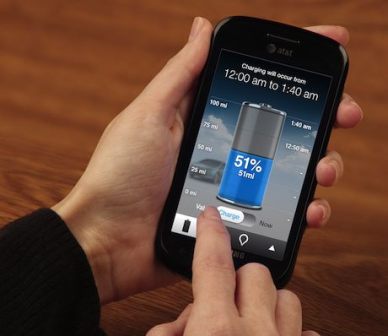Big Data is just digital zeros and ones arranged in patterns. It takes an Internet of Things (IoT)—devices and machines—to generate, gather, arrange, store, and move it. In the IoT, billions of objects containing all sorts of sensors are interconnected over public or private networks that send or receive millions of machine to machine (M2M) messages a minute. Analyzed in other machines, data becomes information for planning, management, and decision-making.

(Ford Focus app Credit – Google Images)
Ford Focus Electric contains its own internet of things that communicates data both within the vehicle and with the company that built it. Owners connect with Ford’s cloud-based secure server via an onboard wireless module and a smartphone app or Ford website. This allows them to access vehicle information like battery state of charge, overall efficiency, energy consumption, and braking regeneration. The car’s communication devices send the owner alerts if the battery isn’t charging, when it’s charged as much as it should be. Connections in the cloud and GPS can report the car’s location when it’s lost in a parking lot, being used by the owner’s teenage drivers, or stolen.
(Now, even your bike can talk to your smart-phone)
Ford also uses the data generated by the vehicles sensors and communication modules. Information it collects from the car is used to evaluate performance. The feedback can also find improvements for design and engineering of next year’s model. It can identify some problems in the vehicle and tell the owner to have the car serviced, or monitor mileage and suggest an oil change. Ford can also use the data for marketing purposes, tailoring marketing messages to an individual’s behavior and use of the car.
Input from objects in customers’ hands removes a level of abstraction, offering manufacturers greater visibility into people’s experiences with their products. But machines cannot capitalize on this information independently. Engineers, designers, and others workers must take the information gathered by these machines and leverage it appropriately.
Product development, marketing and manufacturing departments can use this information to collaborate and create better solutions to fundamental product issues. Does the customer’s behavior fit with our expectations? Are there any proactive steps we can take to avoid a negative brand experience? How should we tweak the product’s design to better serve our customers? And what types of quality assurance modifications should we make? These closed loop, integrated decisions, supported by the Internet of Things, will alter how we build, deliver, and design products in the future.
In manufacturing, workstations, machines, and parts send or collect process data to other physical nodes of the factory network to help answer vital questions. Is equipment performing up to par? Is process variability within designated limits? If defects are appearing, when and where are they occurring, what parameters are out of control? Where is each product unit in progressive stages of production?
With instant widespread visibility into production data and new analytical tools, how can faster cycle time and more efficient changeovers be achieved? How can we record, track, and trace critical components like air bags and accelerator units, from the point where they are first produced to any point of use or failure?
Supply chain and logistics giant UPS depends on M2M to continuously monitor the volume of shipping in the system and for speedily sorting and moving it. From package pickup to delivery, data gathered by scanning bar codes or from RFID keeps UPS, the sender, and you informed of your shipment’s location via any connected device and its website. UPS uses onboard devices and GPS to monitor trucks in real time as they follow their routes. Data gathered over a period of time allows the company to rebalance and tweak routes for the most efficient use of time and fuel.( Read more on IoT and Logistics.)
Data belonging to every shipping enterprise in every supply chain, managing goods traveling by every mode of shipping, down to every object in every container in transit—all moves from sensors and microprocessors through radio transmitters, high-speed cables, banks of servers, routers, wireless cellular devices, and other nodes in the Internet of Things.
Aided by machines and information, it is up to people to determine the goals, strategies, and business rules of their organizations. The complex networked information system—its hardware and software—is there to support decision-making and operations. We’re now in an age when to compete, grow, and generate profits, it’s imperative that an enterprise harness the Internet of Things.
Karen Wilhelm has worked in the manufacturing industry for 25 years, and blogs at Lean Reflections, which has been named as one of the top ten lean blogs on the web.
